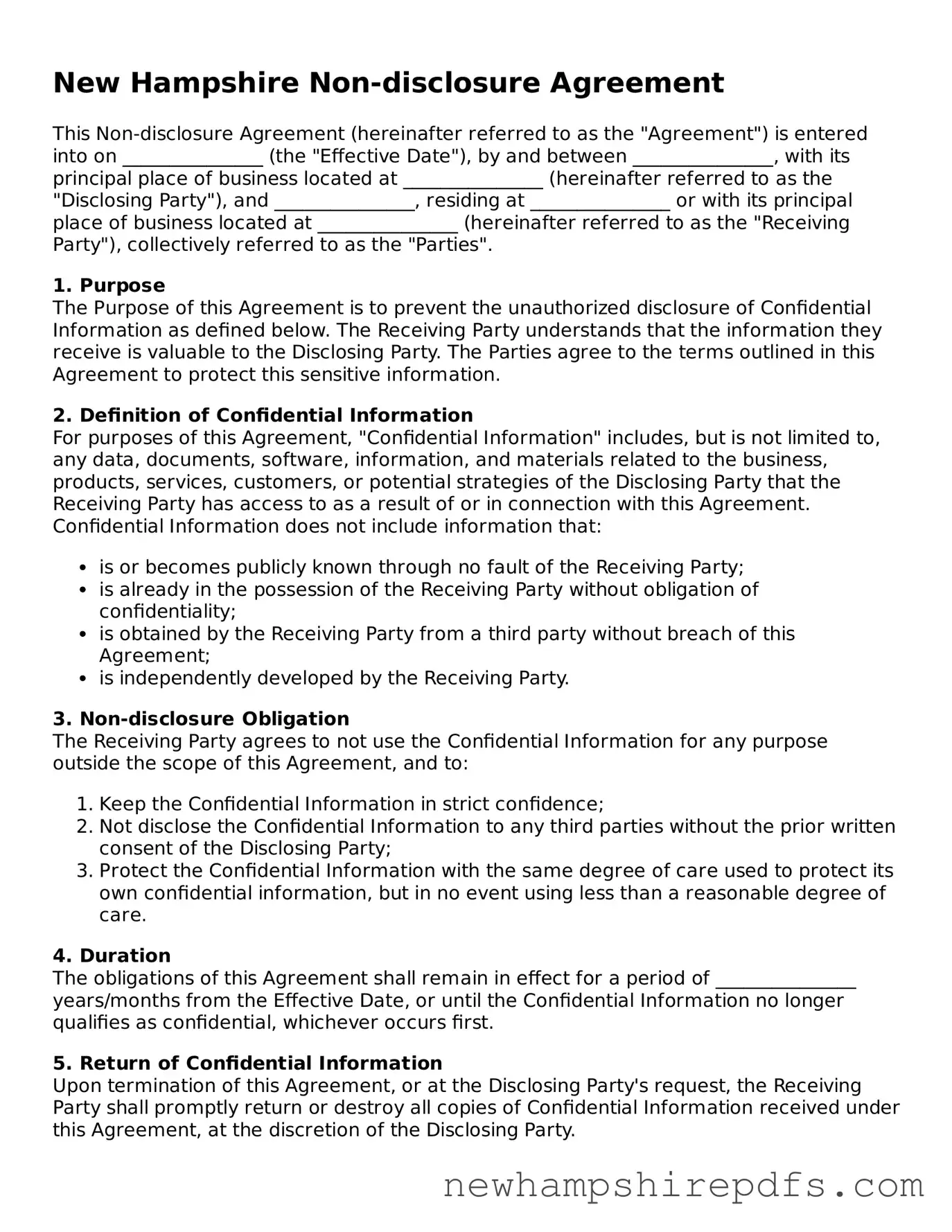New Hampshire Non-disclosure Agreement
This Non-disclosure Agreement (hereinafter referred to as the "Agreement") is entered into on _______________ (the "Effective Date"), by and between _______________, with its principal place of business located at _______________ (hereinafter referred to as the "Disclosing Party"), and _______________, residing at _______________ or with its principal place of business located at _______________ (hereinafter referred to as the "Receiving Party"), collectively referred to as the "Parties".
1. Purpose
The Purpose of this Agreement is to prevent the unauthorized disclosure of Confidential Information as defined below. The Receiving Party understands that the information they receive is valuable to the Disclosing Party. The Parties agree to the terms outlined in this Agreement to protect this sensitive information.
2. Definition of Confidential Information
For purposes of this Agreement, "Confidential Information" includes, but is not limited to, any data, documents, software, information, and materials related to the business, products, services, customers, or potential strategies of the Disclosing Party that the Receiving Party has access to as a result of or in connection with this Agreement. Confidential Information does not include information that:
- is or becomes publicly known through no fault of the Receiving Party;
- is already in the possession of the Receiving Party without obligation of confidentiality;
- is obtained by the Receiving Party from a third party without breach of this Agreement;
- is independently developed by the Receiving Party.
3. Non-disclosure Obligation
The Receiving Party agrees to not use the Confidential Information for any purpose outside the scope of this Agreement, and to:
- Keep the Confidential Information in strict confidence;
- Not disclose the Confidential Information to any third parties without the prior written consent of the Disclosing Party;
- Protect the Confidential Information with the same degree of care used to protect its own confidential information, but in no event using less than a reasonable degree of care.
4. Duration
The obligations of this Agreement shall remain in effect for a period of _______________ years/months from the Effective Date, or until the Confidential Information no longer qualifies as confidential, whichever occurs first.
5. Return of Confidential Information
Upon termination of this Agreement, or at the Disclosing Party's request, the Receiving Party shall promptly return or destroy all copies of Confidential Information received under this Agreement, at the discretion of the Disclosing Party.
6. Governing Law
This Agreement shall be governed by and construed in accordance with the laws of the State of New Hampshire, without regard to its conflict of laws principles. Any disputes arising under or in connection with this Agreement shall be subject to the exclusive jurisdiction of the state and federal courts located in New Hampshire.
7. Entire Agreement
This Agreement constitutes the entire agreement between the Parties concerning the subject matter hereof and supersedes all prior agreements, understandings, negotiations, and discussions, whether oral or written, of the Parties.
8. Amendment
No modification, amendment, or waiver of any provision of this Agreement shall be effective unless in writing and signed by both Parties.
9. Counterparts
This Agreement may be executed in counterparts, each of which shall be deemed an original, but all of which together shall constitute one and the same instrument.
10. Acknowledgment
IN WITNESS WHEREOF, the Parties hereto have executed this Non-disclosure Agreement as of the Effective Date first above written.
_________________________________
Signature, Disclosing Party
_________________________________
Signature, Receiving Party
